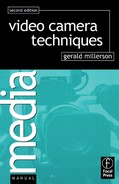The mounting head (panning head) that attaches the camera head to the main camera mounting, does two things:
• It supports the camera securely.
• It allows you to swivel the camera from side to side (panning), and to tilt it up and down (tilting) to follow the action
On lightweight cameras a panning handle (pan bar) fixed to the right side of the mounting head is used to control camera movements, while your left hand adjusts the focus ring on the lens barrel. On larger cameras, two panning handles are normally fitted, with extended focus and zoom controls attached.
The camera may screw directly onto the head, or have a quick-release wedge plate underneath it, which slides into a recessed plate on the mounting head.
Always ensure that your camera is correctly balanced on the head, particularly if you have just added/removed a prompter. Otherwise, if you forget to apply the vertical lock, the camera will drop forwards or backwards, badly jarring the system. A tripod might even overbalance! Many mounting heads include a balance indicator to aid forward/backward adjustment of the camera’s position.
Ideally, the mounting head should offer a certain amount of resistance as you pan and tilt. Too much drag, and moves will be bumpy and erratic, especially on long-focus (narrow-angle lens settings). Too little, and accurate framing is more difficult. You may overshoot at the end of a pan or tilt.
If you want to hold the camera absolutely still (e.g. to avoid movement when shooting a graphic, or when leaving the camera unattended), use the head’s horizontal and vertical lock controls. Over-tightening the drag controls can cause wear.
There are several regular forms of mounting head:
• The friction head which relies on the pressure between parts to steady pan and tilt movements. The weakness of this design is that at the start and end of a slow pan, uneven pressure may cause sudden sticking, and jerk the shot.
• The fluid effect head has low-friction nylon dampers, which provide resistance.
• The fluid head is widely used with lightweight cameras. This has layers of high-viscosity silicon fluid which dampen head movement, and produce very smooth action that is unaffected by temperature changes. Internal springs offer drag resistance.
• The cam heads used for heavier cameras, have internal cams or cylinders to control movement.
Camera mounting heads
Attached to the top of the camera mounting (e.g. a tripod) the camera mounting head or panning head allows the camera head to be tilted and panned, or locked off in any position. One or two pan bars (panning handles) are attached to steady and direct the camera.
Here are two widely used forms (by Vinten), using fluid drag control:
1. For lightweight cameras
2. For heavier camera units with larger zoom lenses and prompters.

